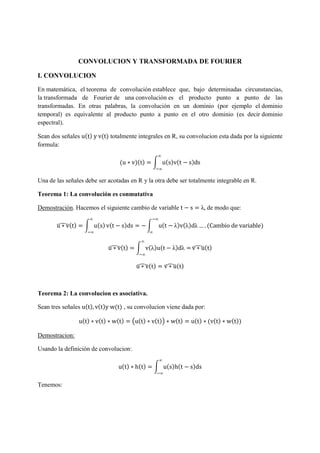Das Dokument behandelt die Konzepte der Faltung und der Fourier-Transformation in der Mathematik. Es beschreibt mehrere Theoreme der Faltung, darunter Kommutativität, Assoziativität, Distributivität und bilineare Eigenschaften, sowie deren Anwendungen. Zudem wird die Beziehung zwischen Faltung und Fourier-Transformation aufgezeigt, insbesondere dass die Fourier-Transformierte einer Faltung dem Punkt-zu-Punkt-Produkt der Fourier-Transformierten der Ausgangssignale entspricht.

![C = [u(t) ∗ v(t)] ∗ w(t) = [ u(s )v(t − s )ds ] ∗ w(t)
∞
∞
La expresión global quedaría:
C = [u(t) ∗ v(t)] ∗ w(t) = [ u(s )v(s − s )ds ]w(t − s )
∞
∞
∞
∞
ds ]
Para:
C = u(t) ∗ [v(t) ∗ w(t)] = u(t) ∗ [ v(s )w(t − s )ds ]
∞
∞
C = u(t) ∗ [v(t) ∗ w(t)] = u(s )[
∞
∞
v(s )w(t − s − s )ds ]ds
∞
∞
Lo que yo quiero probar es:
C = C
u(s )v(s − s )w(t − s )
∞
∞
∞
∞
ds ds
= u(s )v(s )w(t − s − s )ds ds
∞
∞
∞
∞
Hacemos el siguiente cambio de variable: λ = s + s y dλ = ds entonces:
C = u(λ − s )v(
∞
∞
∞
∞
s )w(t − λ)dλds
Luego hacemos el siguiente cambio de variable: θ = λ − s y dθ = −ds
C = − u(θ)v(λ −
∞
∞
∞
∞
θ)w(t − λ)dλdθ
C = u(θ)v(λ −
∞
∞
∞
∞
θ)w(t − λ)dλdθ
Entonces, nos queda:
u(s )v(s − s )w(t − s )
∞
∞
∞
∞
ds ds = u(θ)v(λ −
∞
∞
∞
∞
θ)w(t − λ)dλdθ](https://image.slidesharecdn.com/tranformada-170829025840/85/Tranformada-2-320.jpg)
![Teorema 3: La convolucion es distributiva
Sean tres señales u(t), v(t)y w(t) , se cumple que:
u(t) ∗ [v(t) + w(t)] = u(t) ∗ v(t) + u(t) ∗ w(t)
Demostración:
u(t) ∗ [v(t) + w(t)] = u(t)[v(t − s) + w(t − s)]ds
∞
∞
u(t) ∗ [v(t) + w(t)] = u(t)v(t − s)ds
∞
∞
+ u(t)w(t − s)ds
∞
∞
u(t) ∗ [v(t) + w(t)] = u(t) ∗ v(t) + u(t) ∗ w(t)
Teorema 4: La convolucion es bilineal
Sean tres señales u(t), v(t)y w(t) , se cumple que:
αu(t) + βv(t) ∗ w(t) = α u(t) ∗ w(t) + β(v(t) ∗ w(t))
Demostración:
αu(t) + βv(t) ∗ w(t) = αu(s) + βv(s) w(t − s)ds
∞
∞
αu(t) + βv(t) = αu(s)w(t − s)ds + βv(s)w(t − s)ds
∞
∞
∞
∞
αu(t) + βv(t) = α(u(t) ∗ w(t) + β(v(t) ∗ w(t))
Teorema 5: Propiedad de escalabilidad
Sea:
y(t) = u(t) ∗ h(t) y z(t) = u(at) ∗ h(at), a > 0
Entonces:
z(t) = u(as)h a(t − s) ds
∞
∞
Demostración:](https://image.slidesharecdn.com/tranformada-170829025840/85/Tranformada-3-320.jpg)


![II. TRANSFORMADA DE FOURIER
Sean las siguientes funciones: ( ) ( ) y sus transformadas de Fourier son:
= ( )
∞
∞
= ( )
∞
∞
Sus transformadas inversas son:
( ) =
1
2
( )
∞
∞
( ) =
1
2
( )
∞
∞
Entonces:
Teorema 1:
∗ = [ ( ) ( )]
Demostración:
∗ = ( ) ( − )
∞
∞
∗ = 2 ( )[
1
2
( ) ( )
∞
∞
∞
∞
]
∗ = 2 ( )[
1
2
( ) ]
∞
∞
∞
∞
∗ = 2
1
2
( ) ( )
∞
∞
∗ = [ ( ) ( )]
Teorema 2:
[ ( ) ∗ ( )] = 2](https://image.slidesharecdn.com/tranformada-170829025840/85/Tranformada-6-320.jpg)
![Demostración:
[ ( ) ∗ ( )] = [ ( ) ( − ) ]
∞
∞
[ ( ) ∗ ( )] =
1
2
[
∞
∞
( ) ( − ) ]
∞
∞
Hacemos el siguiente cambio de variable: − = , = + , =
[ ( ) ∗ ( )] =
1
2
[
∞
∞
( ) ( ) ] ( )
∞
∞
[ ( ) ∗ ( )] =
1
2
( )
∞
∞
( )
∞
∞
( )
[ ( ) ∗ ( )] =
1
2
( ) [ ( ) ]
∞
∞
∞
∞
Multiplicamos y dividimos por 2
[ ( ) ∗ ( )] = 2 [
1
2
( ) ][
1
2
( ) ]
∞
∞
∞
∞
[ ( ) ∗ ( )] = ( ) ( )
Teorema 3:
La transformada de Fourier de la convolucion de dos funciones ( ) ( ) es la
multiplicación de las transformadas de Fourier de ambas funciones.
( ) ∗ ( ) = ( ) ( )
Demostración:
( ) ∗ ( ) = [ ( ) ( − ) ]
∞∞
( ) ∗ ( ) = ( )[ ( − ) ]
∞∞
Pero:](https://image.slidesharecdn.com/tranformada-170829025840/85/Tranformada-7-320.jpg)
![( − )
∞
= [ ( − )] = ( )
Finalmente reemplazamos en la expresión:
( ) ∗ ( ) = ( )
∞
( )
( ) ∗ ( ) = ( )
∞
( )
( ) ∗ ( ) = ( ) ( )](https://image.slidesharecdn.com/tranformada-170829025840/85/Tranformada-8-320.jpg)